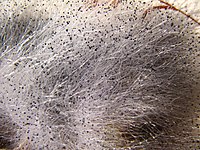
Photo from wikipedia
Abstract Recently, the consumption of greenhouse-grown peaches has declined because of their poor flavor, which makes them unappealing to consumers. In this study, an optimum intensity of 1.44 kJ·m−2·d−1 of ultraviolet… Click to show full abstract
Abstract Recently, the consumption of greenhouse-grown peaches has declined because of their poor flavor, which makes them unappealing to consumers. In this study, an optimum intensity of 1.44 kJ·m−2·d−1 of ultraviolet B (UV-B) radiation increased the sugar accumulation and the total soluble solid/total acidity in ‘Tainongtianmi’ fruit. In the Lumi 1 peach tree variety, 1.44 kJ·m−2·d−1 of UV-B radiation increased the anthocyanin contents twofold in fruit compared with the control. Additionally, the sucrose level increased before the second fruit-expansion stage, while it tended to decrease after the slow-growth period in ‘Lumi 1’ peach trees. The fundamental mechanism in response to the increased sucrose level prior to the second fruit-expansion stage was the increased transport of sucrose to fruit caused by an enhanced tonoplastic monosaccharide transporter function in leaves. The sorbitol content increased in mature fruit owing to the slight increase in sorbitol transporter activity in leaves. Our study indicates that exposure to 1.44 kJ·m−2·d−1 UV-B radiation before the second fruit-expansion period can transiently increase the sucrose and total sugar contents of peach, while prolonged irradiation with UV-B inhibited the accumulation of sugars.
Journal Title: Environmental and Experimental Botany
Year Published: 2018
Link to full text (if available)
Share on Social Media: Sign Up to like & get
recommendations!